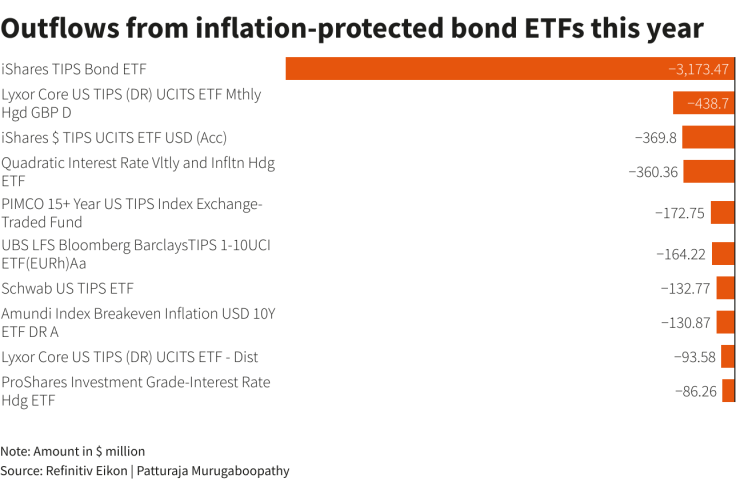Inflation-protected Funds See Big Outflows After Feverish 2021
Global inflation-protected bond ETFs have seen huge outflows this year, despite rising inflation levels, as investors prepare for price pressures to be tamed eventually by central banks.
According to Refinitiv data, global inflation-protected bond exchange-traded funds (ETFs) have faced net sales worth $3.8 billion in the first two months of this year, after receiving inflows over the past few years.
In February alone, they saw an outflow of $2.4 billion, the biggest since March 2020.
A related graphic: Flows into inflation-protected bond ETFs:

The iShares TIPs bond ETF faced an outflow of $3.1 billion, while Lyxor Core US TIPS (DR) UCITS ETF - Monthly Hedged to GBP - Dist and iShares USD TIPS UCITS ETF USD had net sales worth $438 million and $369 million respectively.
A related graphic: Outflows from inflation-protected bond ETFs this year:

Last year, inflation-protected bond funds received a record $48 billion as the post-pandemic economic recovery fanned expectations of higher inflation while supply chain constraints pushed up prices of electronic goods.
Average daily volumes on TIPs approached $22 billion last year, the highest on record, the Securities Industry and Financial Markets Association said.
The turnaround has been dramatic.
"TIPS were a big winner in 2021 and priced in very high levels of inflation for this year. Investors took profits in the first few months of 2022 on a successful trade that had a much higher bar to clear this year," said Andy Kapyrin, director of research at RegentAtlantic Capital.
"Also, its likely that inflation expectations will peak in the coming months, making owning inflation protection more complicated."
The Treasury break even inflation curve, a measure of what inflation level a investor would break even on a given Treasury note yield, shows that investors expect inflation to run at 5.16% in the coming year, before declining to 4% in two years, 3% in five years and 2.6% in 10 years.
A related graphic: Hot inflation seen cooling off down the road: https://tmsnrt.rs/3hqqIzZ
The U.S. personal consumption expenditures price index rose at a 6.1% annual rate through January, its highest since 1982 and a level more than triple the 2% inflation rate the Fed had set as its target for the U.S. economy.
"While inflation readings have been getting hotter, investors are also expecting the Federal Reserve to take more aggressive action to put out the fire," Morningstar said in a report last month.
"With TIPS selling off, the market isn't reacting to the inflation news, it's reacting to expectations of strength by the Fed."
Last week, Fed policymakers largely signalled a preference for a quarter-percentage-point interest rate rise when it begins its tightening cycle at its next meeting.
However, some analysts expect moderate inflows into inflation-protected bonds due to higher crude oil prices and tensions over Russia's invasion of Ukraine.
RegentAtlantic Capital's Kapyrin said the conflict in Ukraine could support flows into the shortest term TIPs on the risk of rising fuel prices.
"I think flows will even out and I don't expect a lot of net inflows in the absence of inflation continuing to get worse. With the Fed raising interest rates and some of the supply chain pressures peaking this is getting less likely," he said.
© Copyright Thomson Reuters 2024. All rights reserved.




















